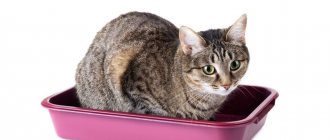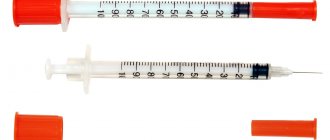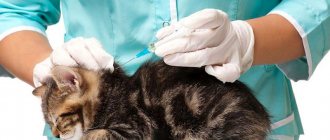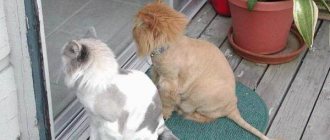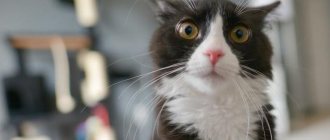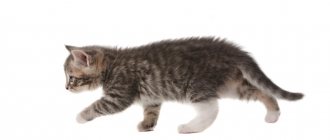Constipation can occur even in healthy, well-fed cats.
How to give a cat an enema at home is useful for every loving owner to know - especially if the breed is prone to problems with the gastrointestinal tract. The procedure as a whole is not difficult, so any cat owner can handle it.
When is an enema necessary?
The procedure for forced bowel movement for a cat becomes relevant if constipation is observed for 3-4 days. Under what conditions do such violations occur? Typically, constipation is caused by the following reasons:
- incorrect diet when the cat consumes food low in fiber,
- reaction of a cat’s body to food that is not suitable for him,
- a number of diseases, acute stress,
- foreign objects entering the colon, which can be passed through the stool.
But the enema itself should be prescribed by a veterinarian during the appointment, after a thorough examination of the cat. After all, an incorrectly prescribed procedure can greatly aggravate the situation. And only in cases where you know that your pet’s chronic problems are his personal characteristic, will you be able to carry out manipulation when you yourself see the need. But, in most cases, a one-time enema and normalization of nutrition help to forget about the problem.
By the way, the first enema itself is performed by a specialist. He will tell you how to perform the procedure, what volume of liquid needs to be administered and what solution to choose.
What solutions are used
Medicinal enemas are selected exclusively by a veterinarian.
There are several options for cleansing compositions for home use, but you should also consult your doctor about each of them.
Enema solutions for constipation in cats
| Name | Peculiarities |
| Saline | Dilute in a proportion of 1 liter of warm water and 30 g of table salt. The enema is administered in small portions - 50 ml each |
| With magnesia | In this embodiment, the saline solution is prepared differently:
Cool to the optimal temperature and administer to the animal. |
| Soapy | Dissolve 1 tbsp in 1 liter of water. grated soap. It is recommended to take either light household or children's clothes - they do not contain harmful additives or dyes |
| Herbal | Chamomile infusion is best suited for an enema. Steam 1 tbsp with boiling water (1 l). or a packet of herbal powder. Leave for half an hour, then filter through several layers of gauze. |
| Glycerin | The product (1 tbsp) is poured into 1 liter of warm water, stirred and immediately filled with a syringe with the solution. |
Any of the compositions may be unsafe for your pet: the cat may have contraindications to one of the components of the cleansing enema.
Before choosing the appropriate option, you must contact your veterinarian.
How often can you give an enema and when should you not do it?
In general, giving an enema should be rare so as not to disrupt peristalsis. No more than 2 times every 7 days. There are such types of enema: cleansing and therapeutic.
At the clinic, a specialist will be able to not only give an enema, but also see how it turned out. If there is no result, repeated manipulation is prescribed. If it is impossible to achieve the desired result after a double procedure, the animal needs help of a different order, depending on the causes of constipation.
There are cases in which it is prohibited to give an enema:
- the cat is pregnant;
- presence of injury or inflammation of internal organs;
- tumor-like neoplasms or polyps in the intestines;
- there is suspicion of intestinal bleeding;
- heart problems, congenital heart defects, irregular breathing.
However, often such contraindications are perfectly disguised and are not noticeable to the average person. Therefore, be sure to consult a specialist to determine the real cause of constipation.
Signs and main causes of constipation
Constipation is manifested by the following symptoms:
- no stool for more than 3 days;
- there is little stool and it is very dry;
- the cat sits on the tray for a long time, pushing, but to no avail;
- visits to the toilet are painful for the animal;
- flatulence;
- anxiety;
- the anus is swollen.
The causes of constipation are various:
- Most often, constipation is caused by improper nutrition (excess protein, lack of fiber, in kittens - switching to a different diet), stress, or the formation of a hairball, because the cat constantly licks itself. A newborn kitten cannot poop on its own. The cat licks his tummy, anal area and provokes the process of defecation. If a mother does not take care of her newborn children, they will have problems with bowel movements.
- Less common, but more dangerous causes are internal diseases, tumors and hernias in the intestine, deformation of the colon or rectum, and previous injuries (fractures).
- The most serious case when a cat does not pass feces is a volvulus or a foreign body entering the intestines.
An enema for a cat is an acceptable method of treating constipation only if it is caused by reasons related to improperly selected food or the formation of a hairball. If there are internal diseases or intestinal blockage, an enema is deadly. Therefore, a doctor should make a diagnosis and recommend treatment after examination.
What should alert the owner?
But the first signs in which constipation can be suspected, and which tell the owners that cleansing treatment is necessary, are very eloquent. This:
- strange behavior of the cat when visiting the litter box: uncharacteristic sounds. Plaintive meowing, frequent but “idle” trips to the litter box;
- hard excrement, sometimes there is mucus and blood in the tray;
- absence of excrement for one or two days, whereas usually the cat poops a couple of times a day;
- poor appetite for a long time;
- anxiety during caresses, especially dissatisfaction is caused by touching the abdominal area;
- upon palpation, the animal’s abdomen may tense and be hard;
- the cat behaves sluggishly or restlessly: does not play, does not lick itself, tries to hide, moans or makes plaintive sounds.
Leaving feces inside for a long time poisons the animal’s body.
Note!
The modern pharmaceutical industry offers hundreds of drugs that have a mild laxative effect.
If this becomes necessary, please consult your veterinarian first.
Under no circumstances should cats be given the following drugs and medicines based on them:
- Aloe vera. Suppositories based on the extract of this plant have a laxative effect and have a beneficial effect on the mucous membrane of human intestines, but in animals they too often cause severe allergic reactions.
- Castor oil. The drug, which in the recent past was widely used not only in veterinary medicine, but even in medicine, is now “in disgrace.” It is strongly not recommended to be used to treat animals, since this medicine, even with short-term use, can cause severe disturbances in the digestive process. Cases of poisoning and severe diarrhea resulting from giving castor oil to cats have also been repeatedly described.
- Magnesium sulfate (also called "Epsom salt"). Yes, this remedy has a mild laxative effect, but in animals it can cause severe, unpredictable diarrhea.
- Hibiscus tea. Yes, some owners “stuff” their cats with it for constipation. Such “treatment” does not lead to anything good. Even in humans, this tea not so rarely causes severe poisoning and profuse diarrhea, but the cat’s body reacts to such “treatment” even worse. Don't experiment with your pet's health!
In general, constipation almost always tends to become chronic, which forces owners of sick pets to look for remedies that can be used regularly without risking harm to the cat’s health.
Products suitable for one-time removal of a “clog” may be completely unsuitable for long-term use, and this must always be remembered! Everything is further complicated by the specific features of the biochemistry of the cat’s body. Medicines to eliminate fecal congestion must be selected especially carefully, taking into account the possibility of side effects. It is for this reason that veterinarians and owners themselves prefer to use enemas, since they are not addictive and, when used correctly, do not harm the cat’s health in any way.
How to prepare liquid for a cleansing enema?
You often come across a common option: 2-3 drops of lemon juice or apple cider vinegar are dripped into clean water. But experts are more likely to recommend remedies such as saline solution or chamomile infusion. They are very easy to prepare. Packaged chamomile or a level tablespoon of dry herb is poured with 1 liter of boiling water and left for half an hour. Before administration, if unpackaged material is used, the liquid should be filtered to remove debris and grass.
Also, a solution of pharmaceutical sea salt, without additives, has a good effect, including relieving intoxication. Take 20-30 grams of salt per liter of water. It is important to dissolve the crystals well and be sure to use a liquid free of debris.
But other medications for therapeutic enema should be prescribed exclusively by a veterinarian.
Analogs
Instead of microlism, you can buy drops for your cat to take orally. For example, the drug Slabilen 0.75%, or Guttasil drops 0.75%, capacity -15 ml.
But still, the drug Microlax is more practical for animals. The advantage of microenemas is that the active substances do not need to pass through the stomach or entire intestines and they are not absorbed into the blood. Therefore, this remedy is safer.
An enema is given to adult cats and female cats if they have not defecated for 2-3 days. If the procedure did not help and another 2 days have passed, then you need to contact a specialist. However, it should not be used on pregnant cats. The dose for an adult animal is 0.5 ml, and for a kitten - 0.3 ml.
What is needed for the procedure and how to carry it out?
Giving an enema will require calm and assistance from you. It is better for an adult from the household to help. After all, cats really don’t like such procedures and are in a hurry to run away or can even scratch people. To carry out the procedure you need to prepare:
- a syringe with a rubber spout. After all, he cannot injure the animal’s anus if it resists. The volume is selected according to the weight of the animal: from 100 ml for small kittens to 300 ml for a large cat;
- solution that will be used to perform a cleansing enema. You can perform the procedure with water or a specially prepared liquid. The main thing is that the liquid itself is about 25-30 0 C;
- Vaseline for lubricating the syringe tip;
- disposable gloves;
- container for excrement. This can be any basin, which can then be thoroughly washed.
How to do an enema at home? We follow this sequence:
- fill the syringe with liquid, blow out any remaining air from it;
- mark 2 cm at the tip of the syringe (1 cm for kittens). This is the mark of maximum penetration of the syringe nozzle into the intestine;
- holds the cat well with a soft cloth or towel;
- lubricate the tip of the syringe with Vaseline and insert it with careful screw-like movements;
- slowly and gradually introduce the liquid. Attention! If the introduction of fluid encounters serious resistance or the fluid does not flow at all, you should urgently stop the manipulation and take the animal to the clinic so that the cat can be correctly diagnosed;
- after introducing the liquid, close the anus tightly using the animal’s tail;
- wait about 15 minutes for the stool to soften;
- We place the animal on a spacious basin, and not on a tray. After all, liquid and softened feces can come out. All this can splash and stain everything around.
Thus, the cat’s body will be freed from toxins. But it is necessary to monitor the normalization of stool for another week. And most importantly, you should normalize your pet’s diet.
Veterinarian recommendations
As recommendations, here are the veterinarian's notes:
- The best time to perform an enema is early in the morning.
- Talk to your pet, stroke him. Your calmness and calming tone will prepare the cat, and he will be more willing to trust you.
- Massaging the cat's abdomen under the pelvis will help loosen the fecal impaction. It is in this area that you can feel hard stool.
- Pay attention to the color of the feces excreted with the solution. If they are stained with blood, this may indicate injury to the rectum. This situation requires the intervention of a specialist.
Author of the video channel “And the veterinarian is against!” Veterinarian by profession. In this video, he talks about when to give an enema to a cat.
Sorry, there are no surveys available at this time.
